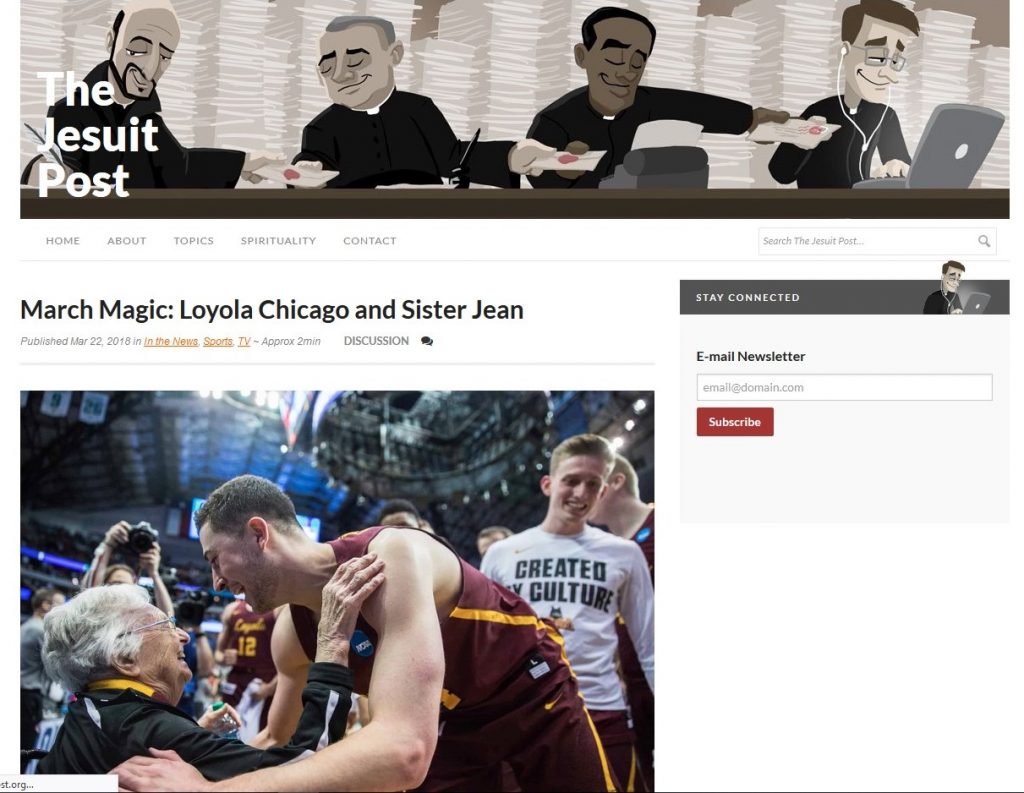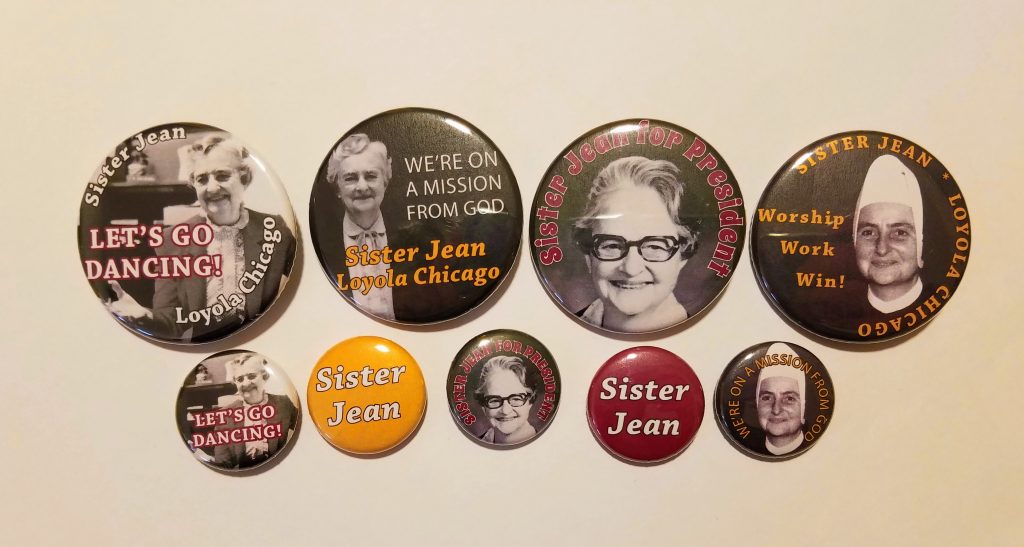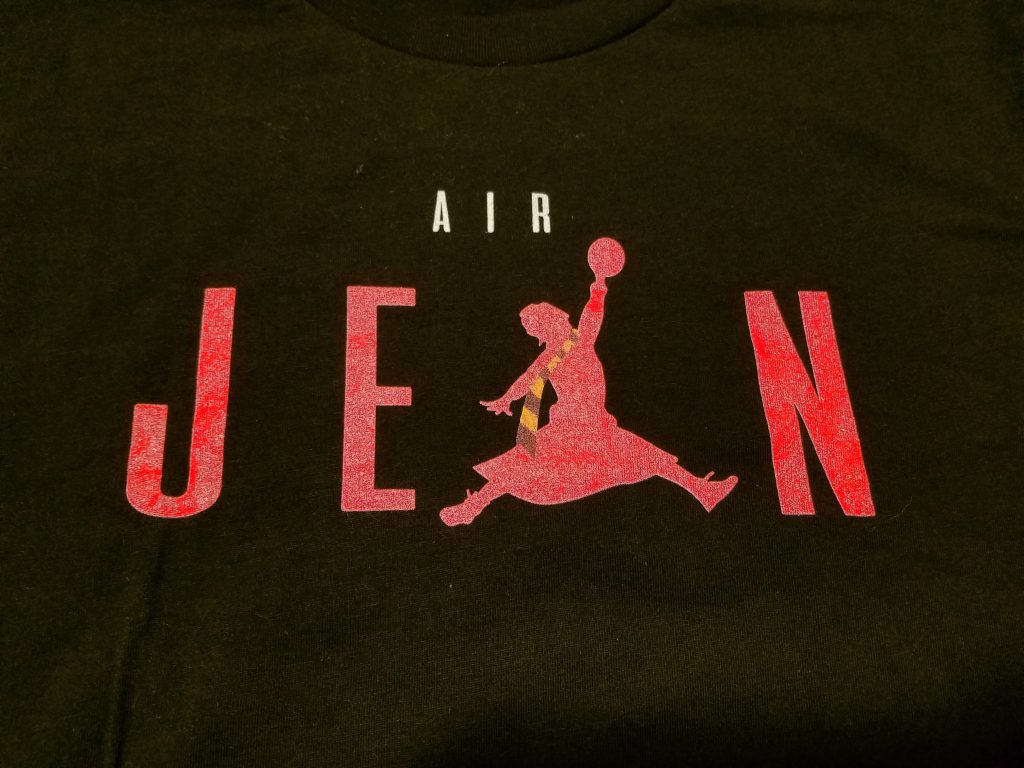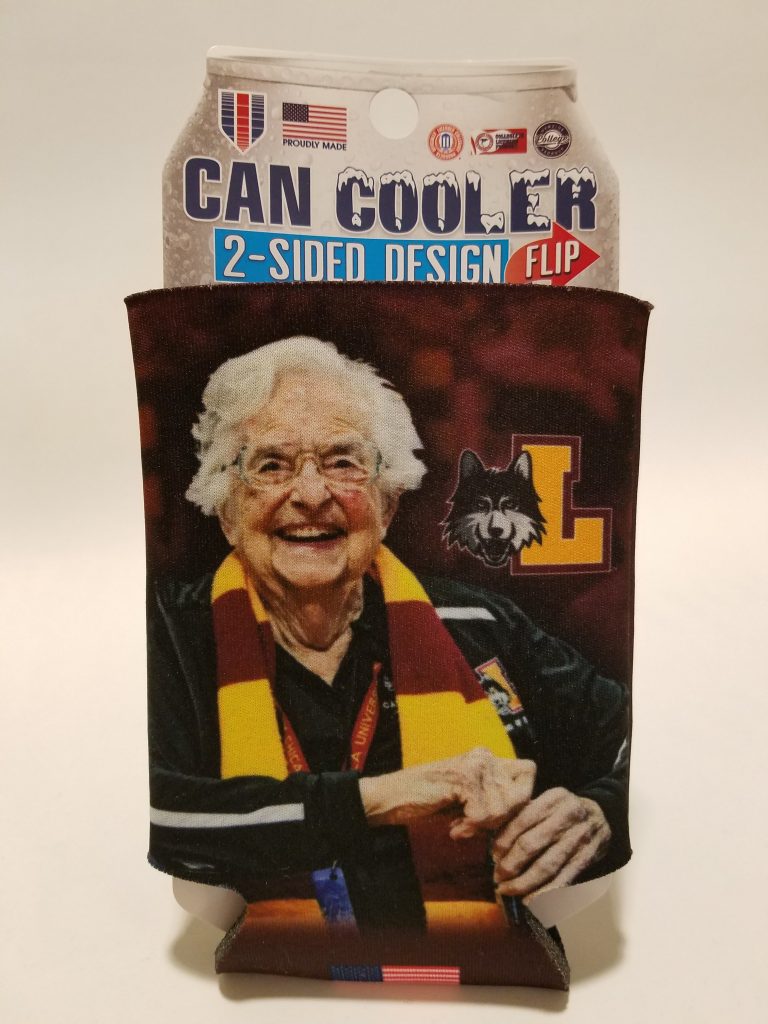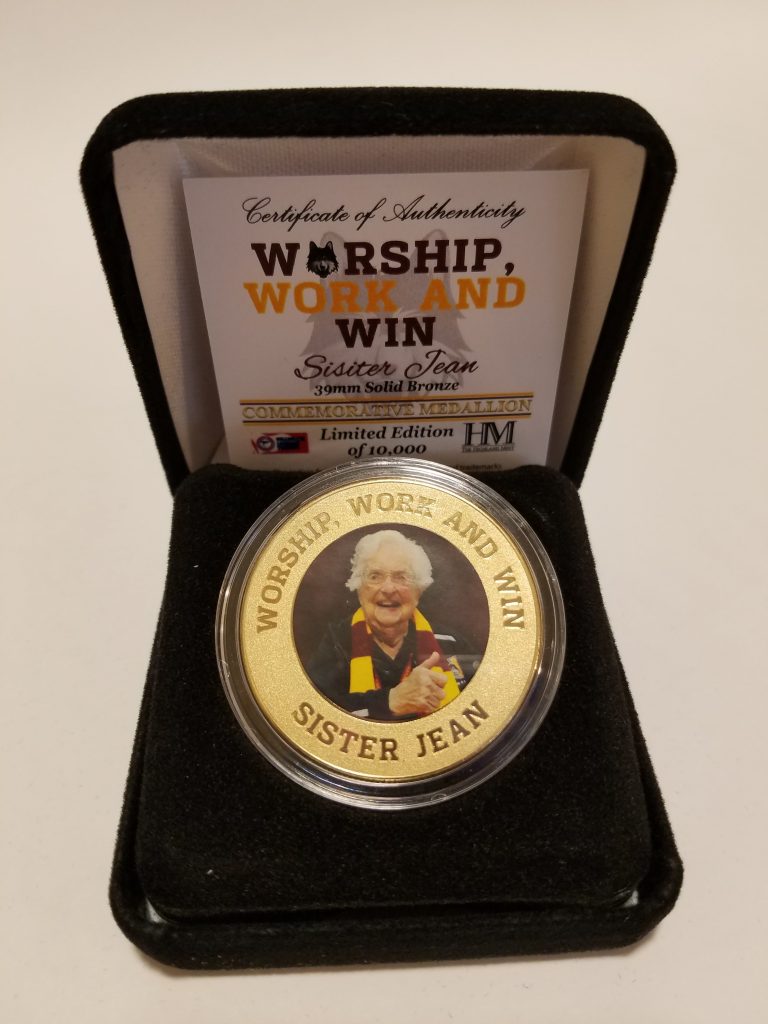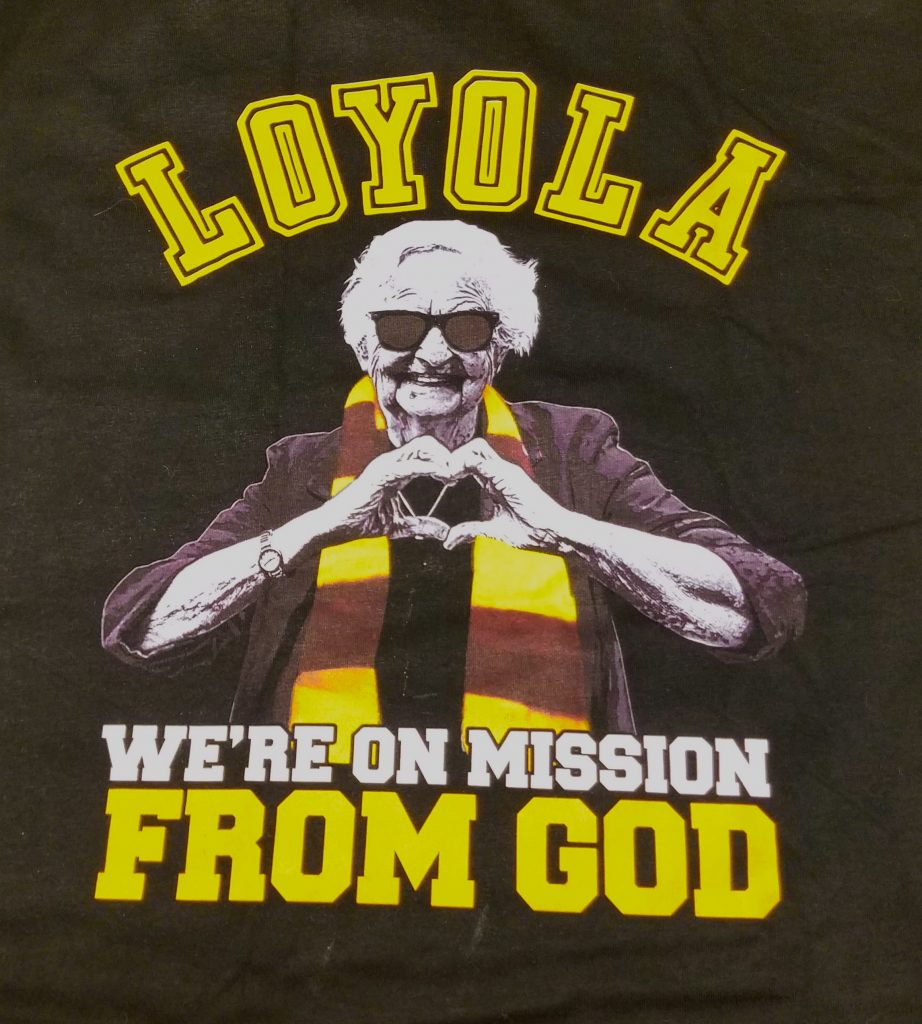Over the course of my two years at the Women and Leadership Archives (WLA) I’ve had the privilege to work with a lot of the collections we hold. From academics, artists, homemakers, social justice activists, women religious, nurses, politicians, business leaders – almost any vocation or subject you could name we’ve got a collection in which a woman or group of women were involved and rocking at it. Though I’ve yet to come across a collection that didn’t engage me, I have to admit that I have my favorites. What follows is my “hit parade” of my favorite collections at the WLA:
Category Archives: Mundelein College
A Haunting of the BVMs
With the start of October comes many changes; cozy sweaters, hot chocolate, pumpkin spice, and, of course, Halloween. There is nothing more appropriate for this month than a good scary story, and luckily, here at the WLA we have one in our very own collection! There is an account told by Sister Mary Ernestine, BVM* of stories she heard from Sister Isabella Kane** of strange happenings experienced by her and other sisters. Here is that story:
Sister Isabella Kane was about fourteen years old when she entered the BVM Community and having experience with piano, she was sent to teach music. She was a natural and enjoyed her time teaching, but especially loved painting in the music room after night prayers when it was empty. One night Sister was painting when the door suddenly flew open. Thinking it was one of the sisters trying to mess with her, she paid it no mind and shut the door. She settled down to continue painting when the door flew open again. After checking the hallway and finding it empty, she ran to bed.
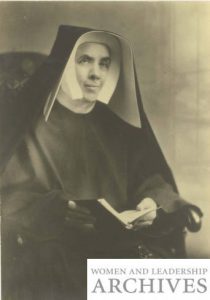
Mother Superior Mary Isabella Kane, BVM
That wasn’t the last time Sister Isabella would experience strange occurrences.
Sister Isabella and the other sisters rented a large three story double house to be used as a school as well as house the sisters. The sisters living in the convent complained of noises: banging on doors, knocking of wooden beds, and other demonstrations of what they believed was “the Evil One.”
One sister was thrown off her bed, another was unable to control violent trembling as night approached, and one more found as she headed down the stairs, two fireballs appeared in the landing. Though the superior was not convinced of any haunting (and believed it to be all coming from the sisters’ active imaginations), she agreed to move from that home for everyone’s health.
Though we have no way to be sure if it truly was “the Evil One” haunting the sisters, the mystery still persists. So Happy Halloween everyone, hope it’s a spooky one!
*BVM stands for Sisters of Charity of the Blessed Virgin Mary, a religious order out of Dubuque, IA.
**Sister Isabella later served as Mother Superior of the BVMs from 1919-1931.
Tina is a Sesquicentennial Scholar at the WLA working to highlight Mundelein in the upcoming 150th anniversary of Loyola. She is currently working on her masters degree in Digital Humanities. Tina is a reformed ice cream hater and is a fan of the flavor Savannah Buttermint at Jeni’s.
Loyola University Chicago’s Women and Leadership Archives Blog is designed to provide a positive environment for the Loyola community to discuss important issues and ideas. Differences of opinion are encouraged. We invite comments in response to posts and ask that you write in a civil and respectful manner. All comments will be screened for tone and content and must include the first and last name of the author and a valid email address. The appearance of comments on the blog does not imply the University’s endorsement or acceptance of views expressed.
Virginia Piper: More Than A Donor
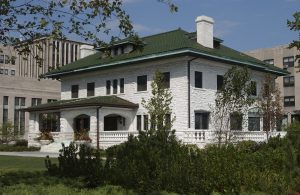
Piper Hall, 2005
Many visitors to Loyola’s campus and Piper Hall, where the WLA is located, are amazed by the beautiful white marble mansion and its incredible location on the shores of Lake Michigan. We are always answering questions about the history of the building as a home and as a library for Mundelein College. However, we do not often talk about how the house got its current name.
Like most buildings on university campuses, Piper Hall was given its name by important donors. In this case, Virginia Galvin Piper donated funds to Mundelein College and had the building named after her late husband, Kenneth Piper. The building was later renamed the Virginia G. and Kenneth M. Piper Hall in honor of the couple.
I myself had not given much thought to who these people were, until I came across several files in the Mundelein College collection containing correspondence, informational pamphlets, and a book written to share the life and legacy of Virginia G. Piper. In this book, I found a story more enthralling and inspiring than I ever imagined.
The story of Virginia Piper is intertwined with the story of Chicago. It has more human drama and heartache than a novel. There is romance, tragedy, transformation, and even a mysterious unsolved murder. Lucky for you, the text of the book, Devotedly Virginia, has also been put into a lovely website where you can read all of the challenges and triumphs of Virginia and the many individuals who shaped her life. Trust me, it is much more interesting than you might think.
In this post, I would like to share some of the highlights of the story and add details about Virginia Piper’s relationship with Mundelein College and her deep friendship with the college’s longtime president, Sister Ann Ida Gannon.
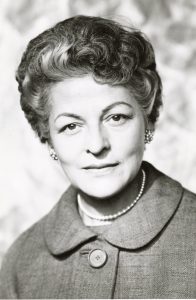
Portrait of Virginia, 1965
Born in 1911, Virginia grew up with humble roots and a loving family. Her close relationships with her mother, her sister, her grandmother, and many female friends shaped the woman she became. As a young woman, she worked hard to help her parents through the Great Depression and did not marry until she was 33. This first marriage, to Motorola founder and public figure Paul Galvin, transformed her life. Along with love and happiness, the union led to Virginia’s conversion to Catholicism and her introduction to the world of philanthropy. When Paul died in 1959, Virginia chose to take control of the Paul V. Galvin Charitable Trust. This began her forty-year career as a philanthropist.
Virginia took her new position seriously. She met with bankers, stockbrokers, and financial advisors to learn everything she could about the job ahead of her. Her active involvement in every aspect of her charitable giving was unique at that time, especially for a woman.
According to Virginia’s biography, the remarkable woman’s relationship with Mundelein College began with a phone call to another remarkable woman, college president Sister Ann Ida Gannon, in 1964. Virginia likely saw Mundelein as a perfect fit for charitable gifts, as it shared the late Paul Galvin’s dedication to education and faith. The first gift recorded in the Mundelein records is a $300,000 donation to build a 350-seat auditorium in the college’s new Learning Resource Center. The Paul V. Galvin Memorial Hall was dedicated on October 30, 1969. At this event, Virginia introduced her friends at Mundelein to Kenneth Piper, a longtime friend and vice president of Motorola. The couple had fallen in love and were married later that year.

Galvin Hall Dedication
In 1972, it was announced that Virginia planned to give $300,000 to set up a scholarship endowment to provide full tuition scholarships to top students. The Mundelein records hold a number of letters Galvin Scholars wrote to Virginia updating her on their successes and thanking her for the role she played in their education.
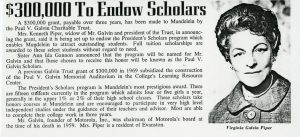
Galvin Scholarship news, 1972
Even in times of personal transition, Virginia remembered Mundelein College. When she and Ken bought a home in Arizona where they would live most of the year, letters show that she gave her dining room furniture and Oriental rug to the college.
Mundelein recognized Virginia’s contributions to the college and many other causes by giving her an Honorary Degree at the 1974 Commencement ceremony. On June 8, a memorial mass was held for Paul Galvin in Galvin Hall before the Pipers and their friends attended the Commencement where Virginia was honored. Many letters from Virginia, Ken, and other friends describe the special day and the gratitude they felt for the experience.
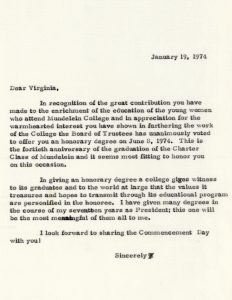
Honorary degree letter, 1974
Ken Piper was a great supporter of Virginia’s work. Letters between Virginia and Sr. Ann Ida reveal that Ken worked “so diligently and hopefully” on plans for a Women’s Executive Institute at Mundelein that he would support. Unfortunately, Ken passed away suddenly in January of 1975 before these plans could be realized. Sr. Ann Ida flew to Arizona as soon as she could and stayed by Virginia’s side for 10 days to help her through the difficult time, a testament to their strong bond.
Virginia lived another 24 years after losing her second husband and dedicated the rest of her life to her work. Just eight months after Ken’s death, Virginia returned to Mundelein College for the dedication of the Kenneth M. Piper Hall, Center for the Study of Religious Education.
Virginia continued to give to Mundelein for scholarships and other projects. After the affiliation with Loyola, she took great interest in the plans for a women’s center to carry on Mundelein’s legacy. She was one of the first donors to the Gannon Center for Women and Leadership and continued to give generously to the project that was named after her dear friend.
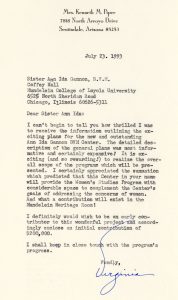
Gannon donation letter, 1993
Virginia Piper and Sr. Ann Ida continued their friendship through letters, phone calls, and frequent visits until Virginia’s death in 1999. Her last gifts and those given by the Virginia G. Piper Charitable Trust after her death went towards renovations to Piper Hall. At the rededication of the white mansion by the lake in 2004, the new home of the Gannon Center and Women and Leadership Archives was renamed to reflect the generosity of both Virginia and Kenneth Piper.
Over 50 years after she began supporting the education of women at Mundelein, Loyola students and the community are still benefiting from Virginia Piper’s contributions. Virginia did not attend Mundelein or grow up in the Catholic faith or have any other personal connections to the school. When looking for projects to support, she saw the potential and the value she was looking for in Mundelein College. And today, when we look at this woman who contributed so much to the growth of Mundelein College, we see someone who embodied the strength, leadership, compassion, and grace that the small Catholic women’s college strove to instill in each of its students.
Learn more about Virginia Galvin Piper’s life and philanthropic work through Devotedly, Virginia and The Virginia G. Piper Charitable Trust, which continues her work. You can also learn more about her relationship to Sr. Ann Ida Gannon and Mundelein College at the Women and Leadership Archives.
You can tour Piper Hall yourself during Open House Chicago on October 13, 2018!
Caroline is a Project Archivist at the WLA currently processing the Mundelein College Records. She is a graduate of the Public History Masters Program at Loyola University of Chicago.
Loyola University Chicago’s Women and Leadership Archives Blog is designed to provide a positive environment for the Loyola community to discuss important issues and ideas. Differences of opinion are encouraged. We invite comments in response to posts and ask that you write in a civil and respectful manner. All comments will be screened for tone and content and must include the first and last name of the author and a valid email address. The appearance of comments on the blog does not imply the University’s endorsement or acceptance of views expressed.
Capturing a Moment: Sister Jean and the 2018 March Madness
March was a great month for the men’s basketball team, Loyola, and of course, Sister Jean. The Women and Leadership Archives holds a collection of Sister Jean’s papers from her career at Mundelein College*. You may have seen photos from Sister Jean’s Mundelein days that we shared on Facebook. While she’s been a celebrity at Loyola for many years, and most students, faculty, and staff have a Sister Jean story, her recent national (pardon me, international) fame created a whole new fan base far beyond our Chicago campuses.
This has been a fun and exciting time in Sister Jean’s legacy, which we want to remember and preserve. In order to capture these moments, I began collecting memorabilia and capturing digital content to add to the Sister Jean collection at the WLA. The work of preserving these memories continues, but here is a small sample of some of the fun Sister Jean souvenirs and stories collected so far.
- Commemorative T-shirt
- Mug with Sr. Jean signature slogan
- Buttons made by the staff at the WLA to celebrate and share the Sister Jean love!
- Tote bag
- “Sweet Sixteen” Commemorative T-shirt
- Commemorative T-shirt
- Drink cozy
- Commemorative Medallion
- “Final Four” Commemorative T-shirt
- Commemorative T-shirt
Not enough Sister Jean for you? Check out these links to some select articles recapturing the magic:
“Before becoming face of Loyola Ramblers, Sister Jean helped women’s college through 1970s student protests” – Chicago Tribune
“Loyola-Chicago’s Sister Jean Becomes Exotic Darling of Final Four Prop Bets” – OG News
“Exclusive: Sister Jean Revealed to be a Villanova Fan” – The Villanovan student paper

Laura is the WLA Assistant Archivist and Programming Librarian at Loyola University Chicago Libraries. She’s a fan of neighborhood festivals, making travel plans, and all things pumpkin (hailing from the Pumpkin Capital of the World).
*Mundelein College, founded and operated by the Sisters of Charity of the Blessed Virgin Mary (BVM), provided education to women from 1930 until 1991, when it affiliated with Loyola University Chicago.
Loyola University Chicago’s Women and Leadership Archives Blog is designed to provide a positive environment for the Loyola community to discuss important issues and ideas. Differences of opinion are encouraged. We invite comments in response to posts and ask that you write in a civil and respectful manner. All comments will be screened for tone and content and must include the first and last name of the author and a valid email address. The appearance of comments on the blog does not imply the University’s endorsement or acceptance of views expressed.
What’s a Dink?
When my husband and I refer to ourselves as dinks and high five, we are celebrating the fact that our status as a “Double Income No Kids” household means we can spend a little more time and money on our current whims and less worrying about finding affordable rent in a Chicago neighborhood with good schools (is this even possible?). When I found the term “dink” on an old green song sheet in the Mundelein College Records, I was pretty sure that the students of the 1940s meant something different.
The songs written and sung for a freshman initiation event hint at the meaning of “dink” and its significance in introducing new students to college life. However, a search of the Mundelein student newspaper, The Skyscraper, failed to bring up a single article giving me more information.
Naturally, I turned to Google to see if this strange term was used in other colleges of the time. I soon found many articles about an interesting tradition that I had never heard of.
Dinks Across the Country
A dink on the 20th century American college campus referred to a beanie cap, often green, worn by freshmen to distinguish them as the newbies. An article on the Penn State University website says that upperclassmen voted in 1906 to require freshmen to wear their dinks at all times on campus and at school events. Freshmen were expected to tip their green caps to upperclassmen and could be subjected to embarrassing hazing if caught without their dinks. Similar antics occurred at many schools in the East and Midwest. In most cases, women on co-ed campuses were not included in the dink tradition, at least at first. Female students at Penn State wore green ribbons in their hair before donning the dink with their male peers in 1954.
The Ohio State University Archives created a fun digital exhibit dedicated to the various freshman beanie traditions found in the colleges of the Big 10. In theory, the beanie was intended to promote school spirit and bonding among freshmen. However, it seems like the real bonding of Ohio State freshmen may have come more from a shared fear of being caught without your beanie by the group of juniors authorized by the Student Senate and the President of the University to throw beanie-less freshman into a nearby lake. It is obvious the beanie did not represent camaraderie to the wearers, as students gathered at the end of their freshman year for the annual “Cap Bonfire.”
In most cases, the cap customs came to an end in the 1960s. However, the tradition lives on in a more benevolent form at Hood College in Maryland. Each class at Hood is given a different color beanie so that the caps are used beyond the initiation period to proudly distinguish each graduating class.

At Hood College, junior students in yellow beanies welcome freshmen students of the class of 2020 by presenting them with blue beanies at the 2016 Convocation. Photo courtesy of Hood College.
Dinks at Mundelein
Finding details of the use of the “dink” at Mundelein College was more difficult than my Google search. Although I found a few signs of dinks and beanies being worn by freshmen, the scarcity of information leads me to believe that this was not a continuous tradition at Mundelein. I found a few photos of students wearing the little caps, often at freshman events. However, most photos of freshman picnics and orientations show bareheaded young ladies, so the requirement to wear the cap must have been a rare and unenforced ritual.
Analyzing the songs from 1940 gives us a good bit of information about what the dinks meant at that time. The green hats were worn at all times by the freshmen for some period of time at the beginning of their first semester. Freshmen were expected to give a salute when encountering upperclassmen and perform other tasks. Getting caught without your dink would cost you 2 cents. No wonder the freshmen are singing of how glad they are to remove their caps..
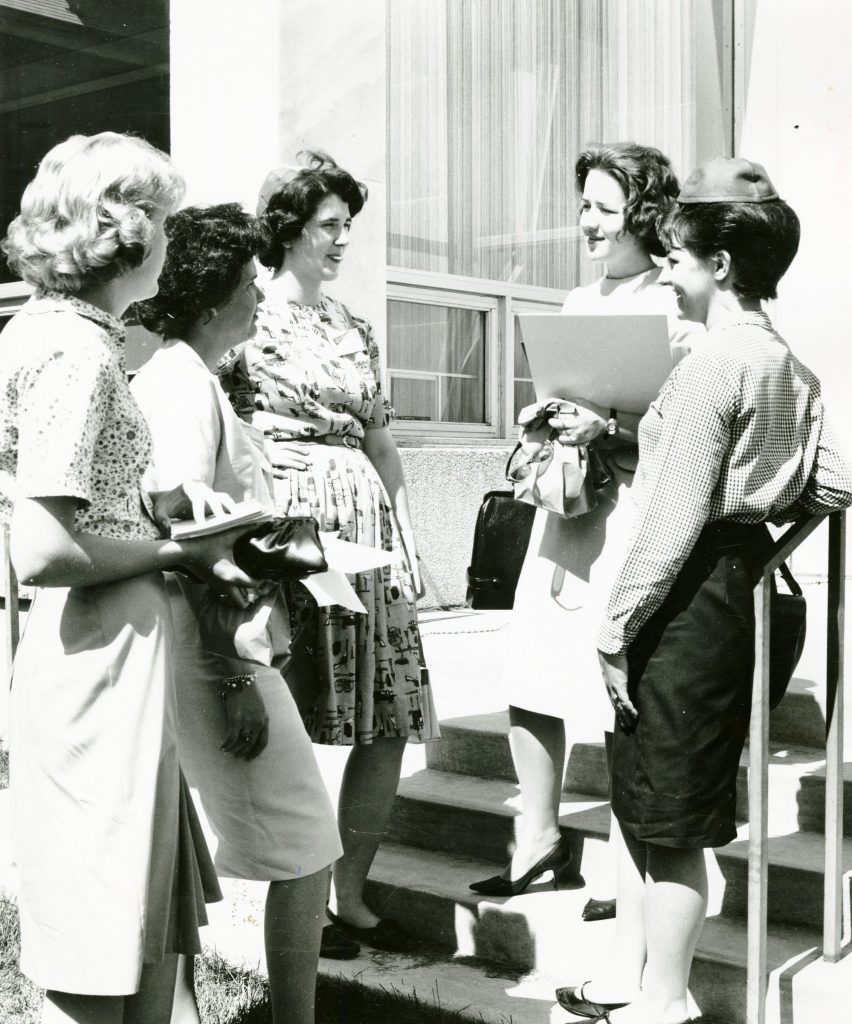
Members of Big Sisters chat at Mundelein College in the 1950s. Are the two students in beanies their freshmen “Little Sisters”?
Most references to the freshman beanie at Mundelein are in connection with the Big Sisters organization. The Big Sisters were nominated sophomores and juniors who took on the job of welcoming and mentoring the incoming freshman class, adopting “Little Sisters” to guide individually. Another song sheet from the Big Sister’s Mardi Gras Tea on February 25, 1941 refers to the green dinks that the “Freshies” wore in their first semester.
“Remember the days—
You were but Freshies green,
And dinks you wore
Which made you quite serene.
Freshies, then and still—
But now Sisters too,
My pledge I renew- faithful to you—
I give you my word.”
Whether or not the young pupils actually felt “serene” in their beanies, the records of the Big Sisters point to good intentions of the upperclassmen to use the beanies to identify and offer friendship to new students. An article in the Skyscraper from 1965 mentions that freshmen were given their “traditional red beanies” by the Big Sisters at a reception during orientation week. This description of the red beanie matches up with the one real piece of evidence we have that was recently donated to the collection. By this time, the beanies seem to be more about school spirit and a welcome to the community than about calling attention to the “greenness” of the freshies.

This felt “dink” in Mundelein College colors is the only one in the collection and was likely worn in the 1960s.
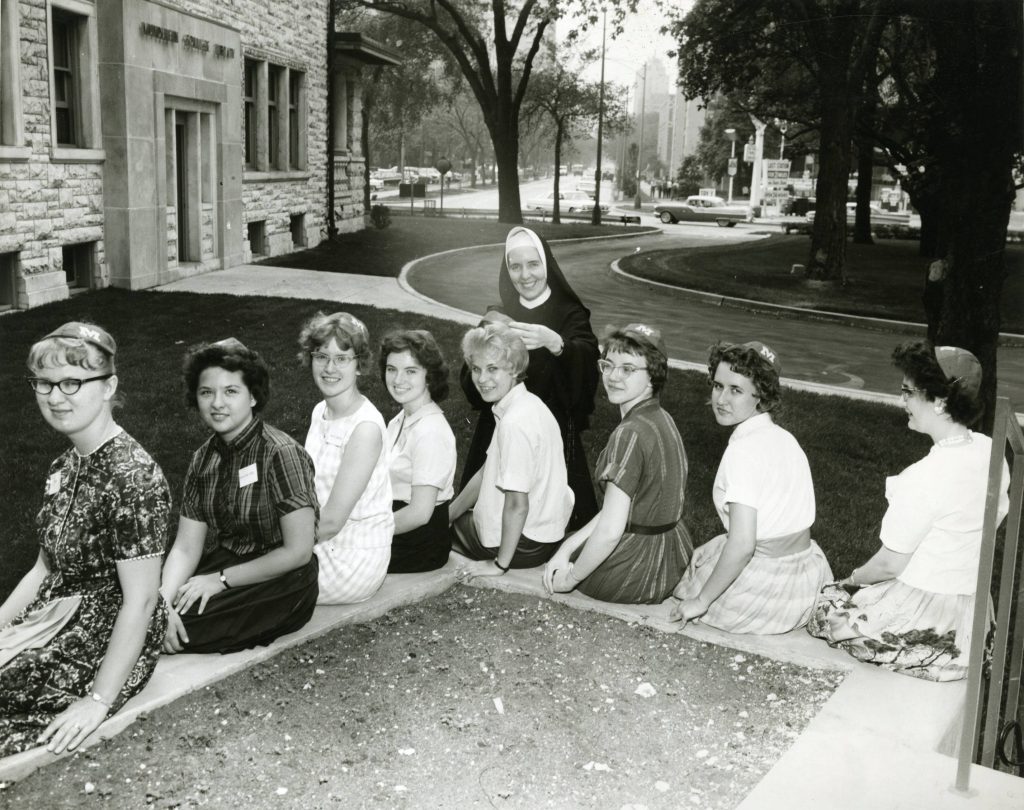
The top-ranking freshmen of 1966 pose in their Mundelein beanies. This is the only photo we have of a group of freshmen all wearing their caps.
I found one other way that the green dink impacted life on the Mundelein campus and it relates to the boys next door. From 1949 to 1961, freshmen students from Loyola University and Mundelein College came together at the beginning of the fall semester for a mixer they called the “Beanie Bounce.” The dance, sometimes hosted by Loyola and sometimes planned jointly by both student activities councils, officially introduced the new freshmen to their neighboring students. In early years of the dance, each Loyola boy would give his beanie to a Mundelein lady in the course of the night, but a Skyscraper article from 1960 describes how the game evolved over the years.
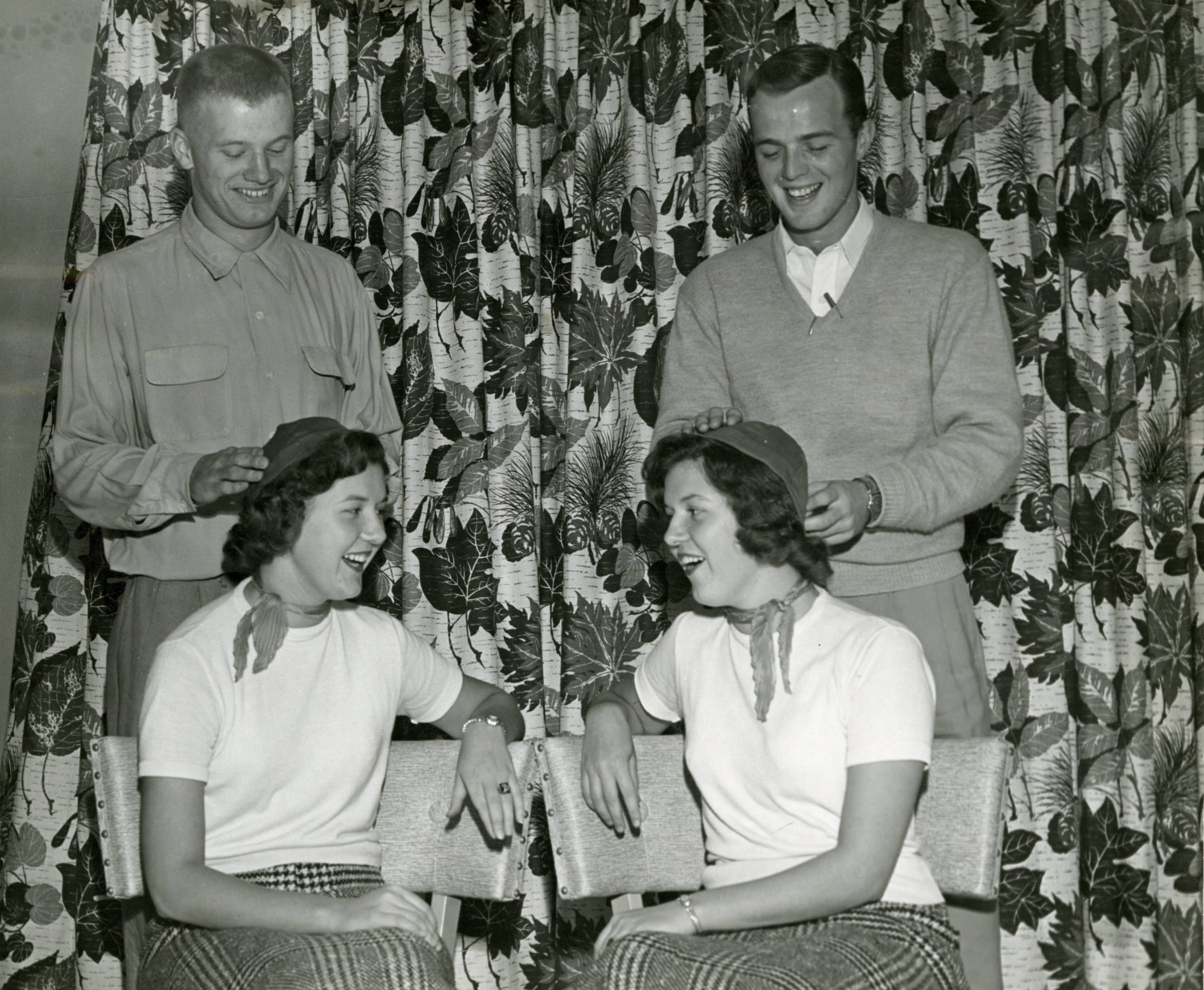
Loyola freshmen Joe Doody and Jim Whiting demonstrate the Beanie Bounce tradition, passing their green caps to Mundelein freshmen twins Rita and Louise Kozak at the 1953 dance.

A Skyscraper article from October 19, 1960 recounts the activities of the “Beanie Bounce” on Loyolas Campus.
A 1984 photo of Mundelein College freshmen at orientation shows three students wearing white and red beanies, a sign that the love for the little hats continued in some form for many years.
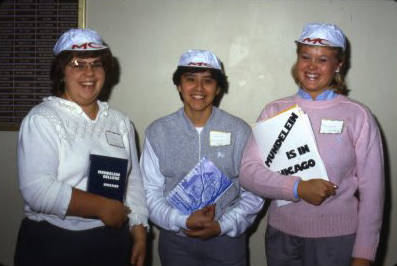
Three Mundelein College freshmen proudly sport little white caps at freshman orientation in 1984.
I remember being a scared freshman and can’t imagine the added anxiety associated with the dink hazing traditions. However, when used as a symbol of welcoming the next generation into the college community, its hard not to get nostalgic for the chic little freshmen caps. I vote school bookstores add the vintage felt beanies to their shelves of sporty caps.
Did you have a dink at your alma mater? Are you a Mundelein alumna with a memory of the beanies? We would love to hear your stories and see your photos!
Caroline is a Project Archivist at the WLA currently processing the Mundelein College Records. She is a graduate of the Public History Masters Program at Loyola University of Chicago. Caroline has a talent for looking good in almost any hat, but always forgets to wear them.
Loyola University Chicago’s Women and Leadership Archives Blog is designed to provide a positive environment for the Loyola community to discuss important issues and ideas. Differences of opinion are encouraged. We invite comments in response to posts and ask that you write in a civil and respectful manner. All comments will be screened for tone and content and must include the first and last name of the author and a valid email address. The appearance of comments on the blog does not imply the University’s endorsement or acceptance of views expressed.
Mundelein College Remembers Them: Alumnae Files in the Archive
Have you ever wondered what happened to your parents’ college materials, or what could happen to your own file from your undergraduate or graduate career? After working with the vast archival collection of Mundelein College (MC), I’m tempted to call my parents’ universities and see if they have archival records.
The Women and Leadership Archives was founded on the collection of MC, which was run by the Sisters of the Blessed Virgin Mary. In my work as a graduate assistant, my assignment these last few months has been to process certain MC collection series, or topic subsets within an archival collection.
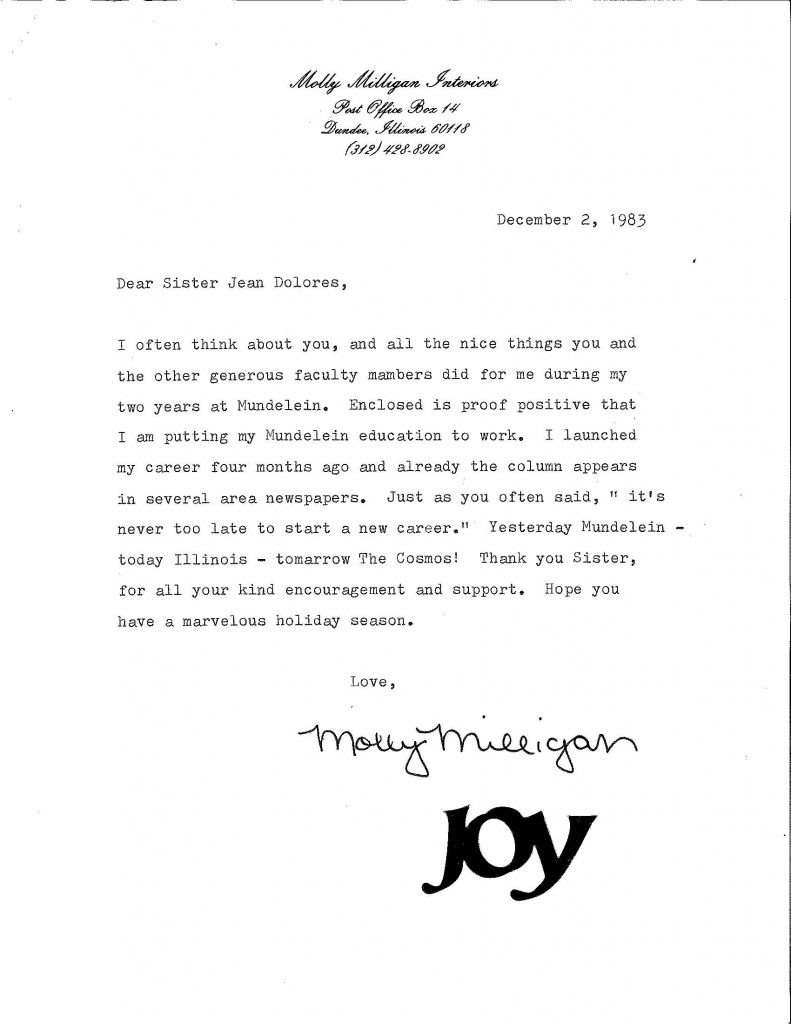
Alumna Molly Milligan wrote to the BVM nuns to express her thanks for what she learned at Mundelein.
One series in particular reminded me that listening is an integral part of learning. While organizing the MC alumnae series, which consisted of files on graduates of the college, I found endless numbers of stories. To my surprise, though it was not difficult physically, it was emotionally draining to process the alumnae series.
Though I tried not to read the materials too closely – that would slow me down – I ended up skimming many of the folders’ contents. As a result, it took me a lot longer than it should have to get through the series. However, I do not regret it: it was incredibly humbling to read these hundreds of folders and learn about the hundreds of lives they represent.
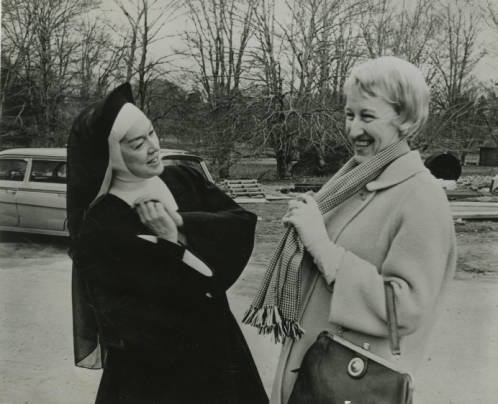
1966: Rosalind Russell and Jane Trahey (’43) on the set of “The Trouble with Angels,” a film based on Trahey’s book, “Life with Mother Superior.”
Mundelein College alumnae documented their struggles and successes from around the country. In letters sent to former University President Sr. Ann Ida Gannon, BVM, they related every aspect of their lives. Much of it was sad. Illnesses abounded – they fought cancers, personal injuries, and their families’ diseases. Some divorced their husbands, and wrote about the hurt they endured afterwards. Many women described their pain at the deaths of parents, spouses, and friends.
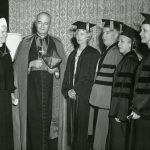
1964: (l to r) Sr. Ann Ida Gannon, B.V.M., Cardinal Albert Meyer, Honorary Degree Recipients: Claire Booth Luce, Dr, Bernice Cronkhite, Maude Clarke, and Dr. Virginia Woods Corbett-class of 1935
On the other hand, many of their stories were positive: they told of their families’ growth, their personal and professional work, and their memories of the college. All of these women loved their college and remembered it affectionately. One graduate and her husband raised ten children and sent regular Christmas cards (with updates) to Mundelein’s nuns. I felt as if I got to know the family through their formative years! Several women started their own businesses, both in Chicago and elsewhere. Helen Sauer Brown (‘44) and Jane Trahey (‘43) both launched successful careers in the business world. Still others achieved extraordinarily high academic honors. Virginia Woods Callahan Corbett (‘35) was Mundelein’s first student to obtain a doctorate, and Jacqueline Powers Doud (‘62) rose to become the president of Mount St. Mary’s College in Los Angeles.
Time after time, these folders reiterated to me that these women inspired love. The folder often began with a woman’s Mundelein student report cards and progressed through her life. But reaching the end of a folder always hurt: it usually concluded with an obituary. The obituary was often formal, but it became personalized through a letter to Mundelein nuns from the deceased’s grieving husband. In short, this series gave me little glimpses into the lives of Mundelein graduates and the deep care they inspired. They were academics, doctors, artists, and homemakers. They were parents, siblings, and – most importantly at the college – friends.
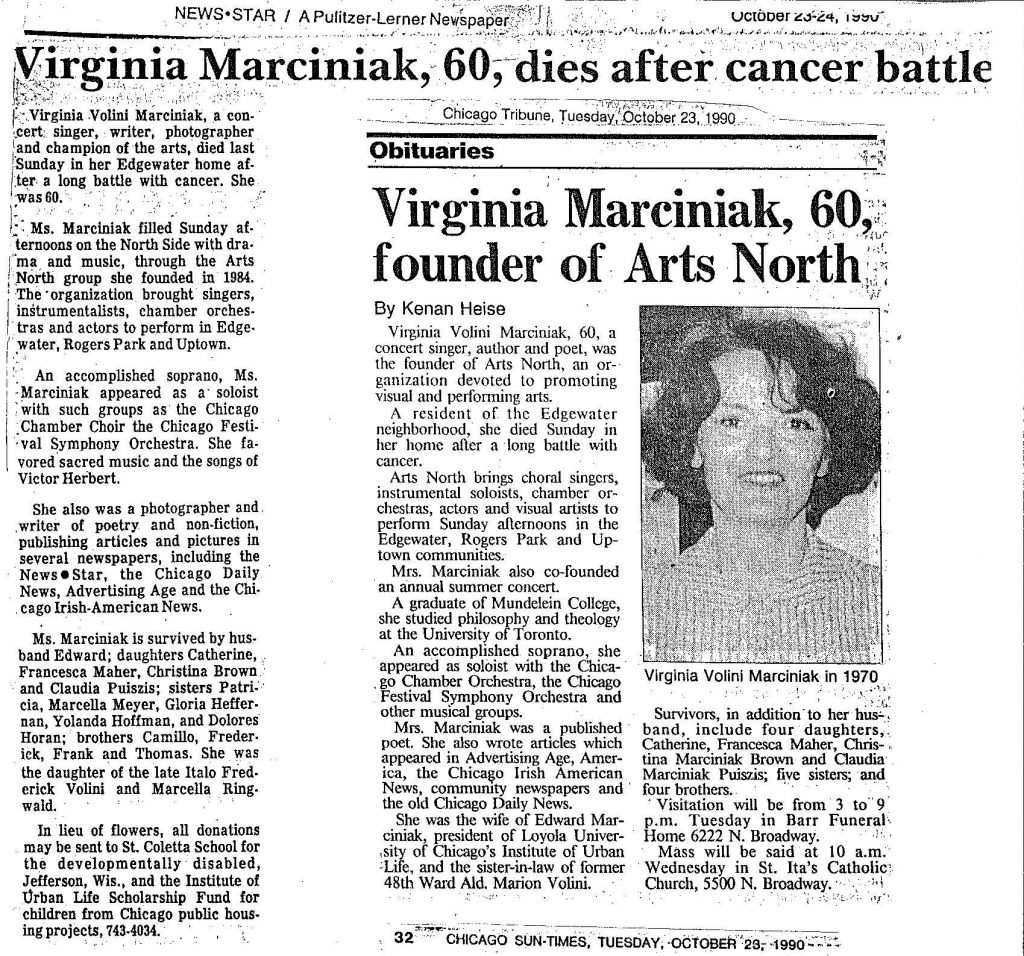
Virginia Volini Marciniak obituary, October 29, 1990
The funeral of one alumn will stay with me for a long time. After a long and involved life, Virginia Volini Marcinak (‘51) died of cancer in 1990. I learned all about her husband Ed – the president of Loyola Chicago’s Institute of Urban Life – and her daughters Christina, Claudia, Catherine, and Francesca. Virginia had a background in choral music and founded an art collective that served the Edgewater and Rogers Park neighborhoods.
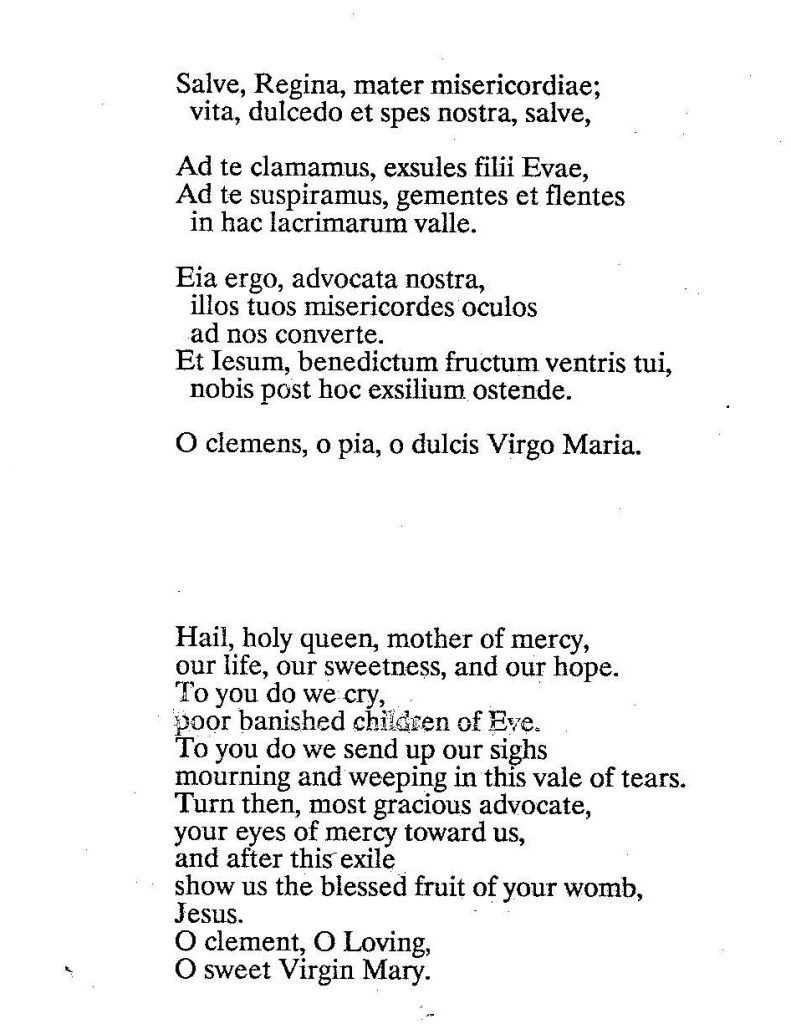
The “Salve Regina” sung at Marciniak’s funeral
Someone sent the Mundelein Archives a copy of the funeral sermon. Though it’s unclear who wrote it, the writer read it aloud at Virginia’s funeral. That person sang a “Salve Regina” to Virginia in her last hours. The last page of the sermon included the words of that song and requested that the attendees join in singing.
Perhaps I should have read fewer of the files, which were often as much about the families and spouses as the women themselves. However, I think I did the right thing. These women lived incredible lives connected by one college and its nuns. Someone should bear witness to those lives, even in a small way.
After reading hundreds of alumnae files, this woman’s tribute brought tears to my eyes. But I think that’s a good thing. Someone needed to bear witness to these lives in the archives, and that day, it was me.
Angela is a Graduate Assistant at the WLA and is in the first year of the MA in Public History at Loyola University Chicago. Originally from the West Coast, she is enthusiastic about swing dancing, choral music, and pub trivia. Angela is also a devoted National Public Radio listener.
Loyola University Chicago’s Women and Leadership Archives Blog is designed to provide a positive environment for the Loyola community to discuss important issues and ideas. Differences of opinion are encouraged. We invite comments in response to posts and ask that you write in a civil and respectful manner. All comments will be screened for tone and content and must include the first and last name of the author and a valid email address. The appearance of comments on the blog does not imply the University’s endorsement or acceptance of views expressed.
The Man from Mundelein
In this blog post I’d like to share a special and humorous story from the Mundelein* collection that highlights an exceptional department at the college, and reminds us that while we still have progress to make in reaching true gender equality, we’ve come a long way.
In 1964, twenty-four year-old, John Harper wanted to become the first man to join the U.S. Army Medical Specialist Corps’ Student Dietitian Program. Established in 1957, the program helped female college students studying home economics become professional dietitians, and in 1964 was opened to men. Despite having his B.S. in Food Nutrition from Illinois Wesleyan University, Harper was just two courses shy of the requirement to enter the program.
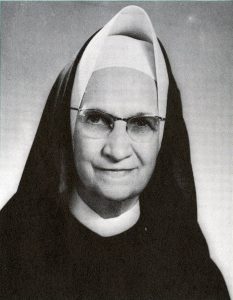
Sr. Mary Pierre
He began searching for Chicago area schools that offered the courses he needed, and discovered that Mundelein College, with its robust Home Economics Department, made the top of a short list. Harper found himself calling the department chair, Sister Mary Pierre, B.V.M. asking if he could register. What Harper didn’t realize (though our regular readers will) was that Mundelein College was in fact, a women’s college.
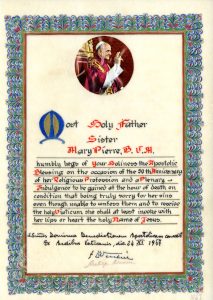
The papal blessing certificate for Sr. Mary Pierre’s contributions to the field of home economics.
Unbeknownst to Harper, the Mundelein Home Ec. Department was nationally known under Sr. Mary Pierre’s leadership, herself a leading figure in the field. In 1946, just two years after the American Home Economics Association was founded, Sr. Mary Pierre organized the creation of the National Catholic Council on Home Economics, with the mission to improve the quality of education in Home Ec. Programs and to demonstrate that science, art, material, and spiritual values could and should be combined. During WWII students in the department were invited by the Nutrition Division of the local Office of Civilian Defense to present demonstrations and programs on meal planning with rations.
Despite the unconventionality of the situation, Harper was admitted to the program as a special student and completed the needed coursework alongside his female colleagues. After graduating, he was accepted to the Army’s Dietetic Internship Program, and trained to serve in Army hospitals throughout the world.
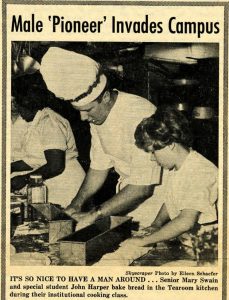
The April 22, 1964 edition of The Skyscraper
If the student newspaper, the Skyscraper, is any indication, the Mundelein student body fully embraced their 1,186 to 1 ratio, and Harper reported: “By this time, I’m used to it. You don’t find too many men majoring in Home Economics, so along about now, it’s second hand!”
*Mundelein College, founded and operated by the Sisters of Charity of the Blessed Virgin Mary (BVM), provided education to women from 1930 until 1991, when it affiliated with Loyola University Chicago.
Kate is a Graduate Assistant at the WLA and in the second year of her M.A. in Public History at Loyola University Chicago. A Colorado gal, she enjoys classic films, bike riding, and all things museums.
Loyola University Chicago’s Women and Leadership Archives Blog is designed to provide a positive environment for the Loyola community to discuss important issues and ideas. Differences of opinion are encouraged. We invite comments in response to posts and ask that you write in a civil and respectful manner. All comments will be screened for tone and content and must include the first and last name of the author and a valid email address. The appearance of comments on the blog does not imply the University’s endorsement or acceptance of views expressed.
Collections Highlight: The Gravity-Defying Botanist
When we think of the National Aeronautics and Space Administration (NASA) today, what comes to mind are trips to Mars and robots on the moon. However, NASA has been supporting students and professors through research grants since its inception in 1958. The WLA collection is fortunate to house the collection of a woman whose work was supported by a NASA grant: Alice Bourke Hayes, a biology professor, Associate Academic Vice President, University President, and all around amazing woman.

Dr. Alice Bourke Hayes in 1959
Alice Bourke Hayes was born in 1937 in Chicago, Illinois. She received her B.S. in Biology from Mundelein College in 1959, and her M.S. in Botany from the University of Illinois at Champaign-Urbana in 1960. After receiving her PhD in Biological Sciences from Northwestern University in 1972, she returned to Rogers Park as a professor and the chair of the department of Natural Sciences at Loyola University. In 1980 she became the Associate Academic Vice President at Loyola, but that did not stop her from continuing her study of botany.
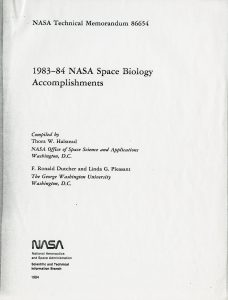
A NASA Report from 1984 featuring Dr. Hayes’ Research
From 1981-1985, Dr. Hayes received grant money from NASA to support her study of pinto bean plants which she had begun in 1969. Under the title, “The Role of Gravity in Regulation of Leaf Blade Form,” she used the money to “understand how the normal leaf maintains its flat form, and how the diseased leaf curls up when infected with microorganisms or exposed to air pollutants”. Dr. Hayes and her graduate students observed the responses to gravitational stimuli, rotation, and amount of indole-acetic acid (a growth hormone) on pinto bean plants’ leaf position and leaf form. In 21 notebooks within our collection, Dr. Hayes’ handwritten observations, graphs, sketches, and data tables track the multitude of experiments conducted over 16 years.
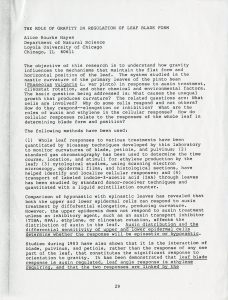
A page from the 1984 NASA Report
In her renewal proposal from 1984, Dr. Hayes summarized what her work meant for the future of space study, and the possibilities of future work:
-For significance of the research: “This could have valuable applications in plant pathology, ecology, and photosynthesis research” (pg. 16)
-For future work: “…gravimorphic phenomena should be investigated in true zero g environments…” (pg. 15)
“The possibility of a gravity-based regulatory mechanism in leaves, clearly indicated by the pinto bean studies, could be confirmed or rejected by studies in the Space Shuttle” (pg. 16)
I am not going to pretend like I fully understand exactly what her data says, but I am not pretending when I say, it is unbelievably cool to have data in our archives that could be used in space.
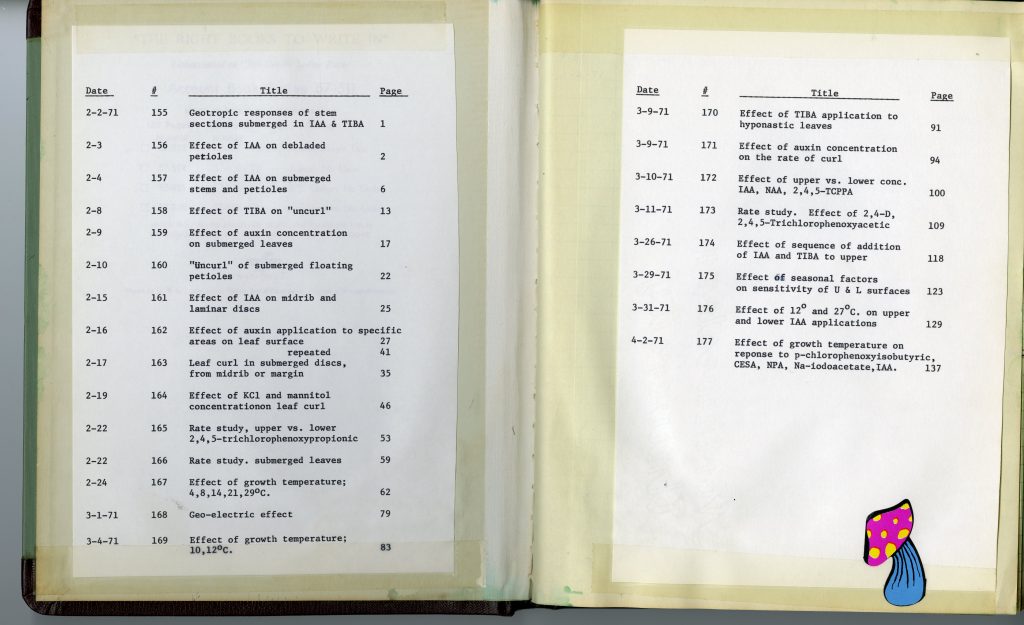
Dr. Hayes’ Journal from 1971
Dr. Hayes encompasses the true drive and passion scientists have: she did not need to study pinto bean plants for 16 years, nor was it part of her contract as Associate Academic Vice President; she did not even use the grant money to pay herself. Her passion, loyalty, and dedication to the field of science is obvious and infectious- read her papers and journals here at the WLA and find out for yourself!
Emily is a Graduate Assistant at the WLA and is in her first year in the joint Public History/Library Information Science program with Loyola University Chicago and Dominican University. She enjoys going on long walks with her puppy, visiting cool museums, and cheering on the White Sox during baseball season.
Loyola University Chicago’s Women and Leadership Archives Blog is designed to provide a positive environment for the Loyola community to discuss important issues and ideas. Differences of opinion are encouraged. We invite comments in response to posts and ask that you write in a civil and respectful manner. All comments will be screened for tone and content and must include the first and last name of the author and a valid email address. The appearance of comments on the blog does not imply the University’s endorsement or acceptance of views expressed.
Remembering Fall at Mundelein
Now that the clocks have rolled back, temperatures have dropped, and scarves have made an appearance, it’s obvious fall is in full swing. Early November is a great time to embrace the nostalgic spirit of the season, cozy up in boots & flannel, and enjoy a selection of autumnal photos from the Mundelein Photograph Collection.
Mundelein College, founded and operated by the Sisters of charity of the Blessed Virgin Mary (BVM), provided education to women from 1930 to 1991 when it affiliated with Loyola University Chicago.

The Richard Twins outside Piper Hall, 1964

Biology students, 1937

Students along the lake front, n.d.

Intramural football game, n.d.

Art students, n.d.

Students share an umbrella, n.d.

Archery students, 1938

Students take a walk, n.d.

Drama students, n.d.

Torchlight Victory Celebration, Homecoming Week, November 8, 1968
Laura is the WLA Assistant Archivist and Programming Librarian at Loyola University Chicago Libraries. She’s a fan of neighborhood festivals, making travel plans, and all things pumpkin (hailing from the Pumpkin Capital of the World).
Loyola University Chicago’s Women and Leadership Archives Blog is designed to provide a positive environment for the Loyola community to discuss important issues and ideas. Differences of opinion are encouraged. We invite comments in response to posts and ask that you write in a civil and respectful manner. All comments will be screened for tone and content and must include the first and last name of the author and a valid email address. The appearance of comments on the blog does not imply the University’s endorsement or acceptance of views expressed.
Women and Leadership Archives Summer Reading List
We at the Women and Leadership Archives love summer reading. If you’re like us, see below for a summer reading list inspired by the WLA’s collections!
For the movie-goers… All the King’s Men by Robert Penn Warren. This Pulitzer Prize winning novel tells the story of southern lawyer Willie Stark and his transformation from an idealistic man of the people to a corrupt politician who pays a high price in his pursuit of power. This loosely fictionalized account of Governor Huey Long of Louisiana boasts two movie adaptations. The first, released in 1949, features actress Mercedes McCambridge—whose personal papers are held in the Women and Leadership Archives! In her collection there is an original script of the film, movie stills, and newspaper clippings describing her Oscar-award winning performance as Sadie Burke.
Collections: Mercedes McCambridge Papers
For the time-travelers…Mundelein Voices: The Women’s College Experience edited by Anne M. Harrington and Prudence Moylan.
Founded in 1929 by the Sisters of Charity of the Blessed Virgin Mary, Mundelein College offered its all-female student body a comprehensive and rigorous Catholic liberal arts education. But Mundelein College, despite being run by nuns, had its share of hijinks! Readers can fully immerse themselves into the goings-on of the student body, and see what it was really like to be a Mundelein student, by reading this anthology of essays. I highly recommend the chapter by Joan Frances Crowley, B.V.M on her eight-year tenure as the director (then dean) of residence life. Anyone that has lived in a dorm will appreciate Crowley’s retelling of what it was like to live on-campus during the 1960s.
Collections: Mundelein College Collection
Joan Frances Crowley, B.V.M Papers
For the thrill-seekers…Red Spy Queen: A Biography of Elizabeth Bentley by Kathryn S. Olmstead
Fans of John Le Carré (of Tinker Tailor Solder Spy fame) will love the fascinating life story of Communist Party and Soviet Union defector Elizabeth Bentley—called the “Red Spy Queen” by tabloids and newspapers in the late 1940s. Interestingly enough, Elizabeth Bentley actually worked as a professor of Political Science at Mundelin College from 1949-1950. Imagine having a spy for a teacher!
Collections: Mundelein College Collection
Marjorie Rowbottom Frisbee Papers
For my fellow feminists…Tidal Wave: How Women Changed America at Century’s End by Sara M. Evans
Historian Sara Evans is an authority on the subject of women’s history and their continued journey to equality. Her first book Born for Liberty (1989) is a comprehensive look at the history of women from the sixteenth century to modern times. In Tidal Wave, Evans establishes the essential foundation necessary to introduce readers to the histories of second and third wave feminism and their lasting importance to the present day. The Women and Leadership Archives holds numerous records of artists, academics, women’s groups, and writers that can add additional context to this groundbreaking time in women’s history.
Collections: Feminism in Chicago: Connie Kiosse
For the scientists…Headstrong: 52 Women Who Changed Science-and the World by Rachel Swaby
This quick colorful book is for anyone who is curious about women’s contributions to the sciences. Divided into disciplines, this encyclopedic book provides brief entries about notable female doctors, biologists, environmentalists, mathematicians, astronomers, inventors; the list goes on and on! When you’re done, feel free to check out some of the WLA’s collections about women scientists
Collections: Mundelein College Collection—Sister Therese Langerbeck Files
Alice Bourke Hayes, PhD., Papers
For the mischief-makers…The Trouble with Angels by Jane Trahey
Originally entitled Life with Mother Superior, this fictionalized memoir by Mundelein Alumnae Jane Trahey describes the shenanigans of two rebellious young women attending a Catholic all girls boarding school. The book was made into a feature film in 1966 starring Hayley Mills as the main troublemaker Mary Clancy and Rosalind Russell as the domineering Mother Superior. If you can get your hands on this book (it’s out of print), you’re in for a light-hearted, nostalgic comedy perfect for laying out pool-side.
Collections: Mundelein College Collection – Jane Trahey Files
For the hopeless romantics…Letters from Home – Kristina McMorris
Sometimes all you want from a good summer read is a juicy historical romance novel. Based in Chicago during World War II, this love story highlights a couple whose only way to communicate with one another is through letters. To add a Shakespearean twist, the main character, Liz Stephens, falls in love with her pen pal while pretending to be someone else! If love letters are your thing, come in and look at the Mollie Leiber West Collection. The WLA holds scores of letters from Mollie to her husband Carl Leiber when they were separated by WWII. Their own tragic love story is not unlike one you would read in an especially romantic novel!
Collections: Mollie Leiber West Papers
Ellen is a Graduate Assistant at the WLA and is in the first year of her M.A in Public History at Loyola University Chicago. Before moving to Chicago, Ellen was a Kindergarten teacher in Louisiana. She enjoys brunch, procedural dramas, and pugs.
Loyola University Chicago’s Women and Leadership Archives Blog is designed to provide a positive environment for the Loyola community to discuss important issues and ideas. Differences of opinion are encouraged. We invite comments in response to posts and ask that you write in a civil and respectful manner. All comments will be screened for tone and content and must include the first and last name of the author and a valid email address. The appearance of comments on the blog does not imply the University’s endorsement or acceptance of views expressed.

